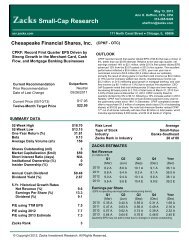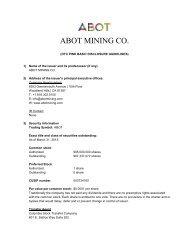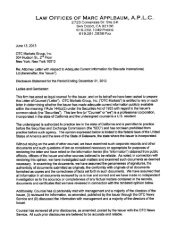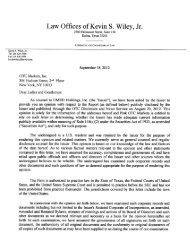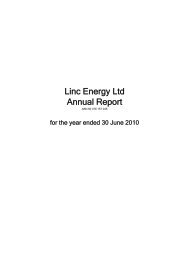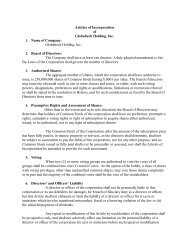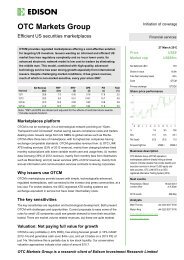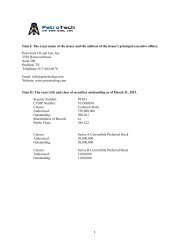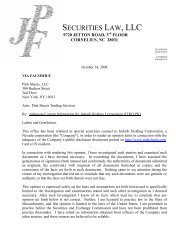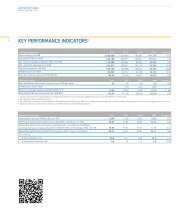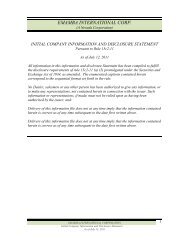2011 Annual Report - OTCIQ.com
2011 Annual Report - OTCIQ.com
2011 Annual Report - OTCIQ.com
Create successful ePaper yourself
Turn your PDF publications into a flip-book with our unique Google optimized e-Paper software.
90 Notes<br />
According to the amendment, such an entity is now permitted<br />
to present the benefit of such a prepayment as an asset where<br />
applicable. The amendment has been transferred by the EU<br />
into European law and thus it is to be applied for fiscal years<br />
beginning on or after January 1, <strong>2011</strong>. This will have no impact<br />
on E.ON’s Consolidated Financial Statements.<br />
IFRIC 19, “Extinguishing Financial Liabilities with<br />
Equity Instruments”<br />
IFRIC 19, “Extinguishing Financial Liabilities with Equity Instruments”<br />
(“IFRIC 19”), was published in November 2009. IFRIC 19<br />
clarifies the accounting treatment of financial liabilities that<br />
are settled through the transfer of equity instruments. The<br />
financial instruments issued are deemed part of the “consideration<br />
paid” as defined by IAS 39.41. The borrower must therefore<br />
fully or partially derecognize the liability. Any difference<br />
between the carrying amount of the financial liability thus<br />
(partially) extinguished and the initial measurement amount<br />
of the equity instruments issued is recognized in in<strong>com</strong>e.<br />
IFRIC 19 is effective for fiscal years beginning on or after July 1,<br />
2010. The new interpretation has been transferred by the<br />
EU into European law. IFRIC 19 has no impact on E.ON’s Consolidated<br />
Financial Statements.<br />
Standards and Interpretations Not Yet Applicable<br />
in <strong>2011</strong><br />
The IASB and the IFRIC have issued the following additional<br />
standards and interpretations. These standards and interpretations<br />
are not being applied by E.ON in the <strong>2011</strong> fiscal year<br />
because adoption by the EU remains outstanding at this time<br />
for some of them, or because their application is not yet<br />
mandatory:<br />
IFRS 9, “Financial Instruments”<br />
In November 2009, the IASB issued the new standard IFRS 9,<br />
“Financial Instruments” (“IFRS 9”). Under IFRS 9, all financial<br />
instruments currently within the scope of IAS 39 will henceforth<br />
be subdivided into only two classifications: financial<br />
instruments measured at amortized cost and financial instruments<br />
measured at fair value. In October 2010, the IASB issued<br />
an extended version of IFRS 9. This version contains additional<br />
requirements for the accounting of financial liabilities. The<br />
application of IFRS 9 was to be mandatory for fiscal years<br />
beginning on or after January 1, 2013. In December <strong>2011</strong>, however,<br />
the IASB published an amendment deferring mandatory<br />
first-time application to fiscal years beginning on or after<br />
January 1, 2015. Earlier application is permitted. The IASB also<br />
amended IFRS 7 in the context of such early application:<br />
depending on the actual date on which an entity initially applied<br />
IFRS 9, there are different requirements regarding the presentation<br />
of a <strong>com</strong>parative period and the associated disclosures<br />
in the notes. The standard has not yet been transferred by the<br />
EU into European law. E.ON is currently evaluating the impact<br />
on its Consolidated Financial Statements.<br />
IFRS 10, “Consolidated Financial Statements”<br />
In May <strong>2011</strong>, the IASB issued the new standard IFRS 10, “Consolidated<br />
Financial Statements” (“IFRS 10”). This IFRS replaces<br />
the existing guidance on control and consolidation contained<br />
in IAS 27, “Consolidated and Separate Financial Statements,”<br />
and in SIC-12, “Consolidation—Special Purpose Entities” (“SIC-12”).<br />
IFRS 10 establishes a uniform definition of the term “control,”<br />
with greater emphasis on the principle of substance over form<br />
than in the past. The new standard can thus give rise to an<br />
altered scope of consolidation. IFRS 10 is generally to be applied<br />
retrospectively for fiscal years beginning on or after January 1,<br />
2013. Earlier application is permitted as long as the standards<br />
IFRS 11, “Joint Arrangements” (“IFRS 11”), IFRS 12, “Disclosure<br />
of Interests in Other Entities” (“IFRS 12”), IAS 27, “Separate<br />
Financial Statements” (“IAS 27”), and IAS 28, “Investments in<br />
Associates and Joint Ventures” (“IAS 28”), are also being applied<br />
at the same time. The standard has not yet been transferred<br />
by the EU into European law. E.ON is currently evaluating the<br />
impact on its Consolidated Financial Statements.<br />
IFRS 11, “Joint Arrangements”<br />
In May <strong>2011</strong>, the IASB issued the new standard IFRS 11. It<br />
replaces IAS 31, “Interests in Joint Ventures” (“IAS 31”), and SIC-13,<br />
“Jointly Controlled Entities—Non-Monetary Contributions<br />
by Venturers” (“SIC-13”). The standard will in future distinguish<br />
between two types of joint arrangements: joint ventures



